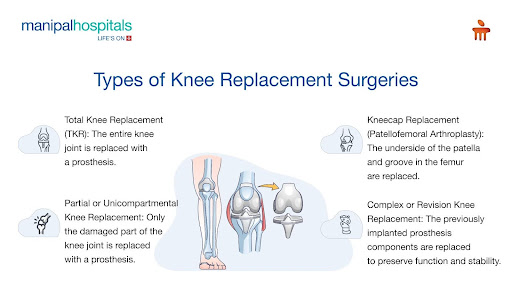Knee issues are increasingly prevalent today, significantly impacting patients' ability to walk or climb stairs. Thanks to advanced medical technology, Knee Replacement Surgery has emerged as a lifesaver and has become the common procedure in orthopaedics. The Knee Replacement surgeries are projected to grow by 673%, with an estimated 3.5 million procedures per year by 2030. Due to growing awareness, India is witnessing a similar trend with more old people opting for Knee Surgery.
Synopsis
What is Knee Replacement Surgery?
Knee Replacement, known as Knee Arthroplasty or Total Knee Replacement, is a surgical procedure that involves replacing the damaged or diseased part of the knee joint with a prosthesis made of plastic and metal.
The knee joint is one of the body's biggest and most complex joints. It is made up of the lower end of the thighbone (femur), the upper end of the shinbone (tibia), and the kneecap (patella). Cartilage (tough, flexible connective tissue) protects the bones and helps them move smoothly with less friction. As cartilage wears down with age or other factors, arthritis and other conditions can develop. These conditions can damage these bones, causing pain, loss of mobility, and friction between bones. Knee replacement can permanently treat this condition and relieve patients from severe knee pain and limited movement.

Benefits of Knee Replacement
|
Pain Relief |
Relieves persistent knee pain caused by arthritis or knee injury |
|
Improved Mobility |
Restores range of motion, allowing patients to perform routine activities like climbing stairs and walking |
|
Enhanced Quality of Life |
Allows patients to live more active and independent lives |
|
Deformity Correction |
Improves leg alignment and stability |
|
Long-lasting Results |
Offers a lifespan of about 15-20 years |
Types of Knee Replacement Surgeries
Below are the common types of knee replacement surgery:
-
Total Knee Replacement (TKR): The entire knee joint is replaced with a prosthesis, used in patients with severely damaged knees due to arthritis or injury, advanced osteoarthritis, and rheumatoid arthritis.
-
Partial or Unicompartmental Knee Replacement: Only the damaged part of the knee joint is replaced with a prosthetic component, which helps patients with localised knee arthritis or specific joint issues that affect only one knee component.
-
Kneecap Replacement (Patellofemoral Arthroplasty): The underside of the kneecap (patella) and the groove in the thigh bone (femur) are replaced, used where only the kneecap gets severely affected by arthritis.
-
Complex or Revision Knee Replacement: Replacing the previously implanted prosthesis with new components to restore its function and stability, performed where a previous knee replacement has failed due to certain complications.
The choice of the type of knee replacement surgery you may need will depend on your surgeon's recommendations and other factors. Visit our expert orthopaedic doctor in Bhubaneswar. for more advice on knee surgery.
Knee Replacement Surgery Procedure
Preparing for the Surgery
Consider these points for its success and quick recovery.
-
A thorough pre-operative evaluation and consultation with an orthopaedic surgeon, assessing your medical history and overall health.
-
Physical examination to ensure you are fit for the surgery
-
Undergo preoperative tests such as blood tests, X-rays, and electrocardiogram (ECG) to check your current health status and identify potential risks, if any.
-
Inform the surgeon of your current medications and discuss which ones to continue or stop before surgery.
-
Arrange for assistance from family members or caregivers to help with tasks during recovery.
-
Adhere to all the pre-operative instructions and fasting guidelines.
During the Surgery
-
You will receive general or regional anaesthesia to feel comfortable and pain-free during the procedure.
-
An incision is made by the surgeon over the knee to access the joint.
-
Damaged cartilage and bone are removed, and the prosthetic knee joint is inserted.
-
Also, a plastic spacer is added for smooth cushioning.
-
The ends of the femur (thigh bone) and tibia (shin bone) are reshaped to fit the prosthetic components if needed.
-
The incision is then closed with stitches or staples, and a sterile dressing is applied.
-
It will take an hour or two for the knee surgery to complete.
Post-Surgery Care
-
You will be shifted to the recovery room, where your vital signs and incision site will be monitored for any possible signs of infection or complications.
-
You will receive pain medications to manage postoperative pain.
-
Begin physical therapy exercises soon after knee operation to improve mobility, strength, and function.
-
The stay in the hospital will be for a few days to ensure proper healing and initial knee replacement surgery recovery.
-
You may need a walker or crutches to aid in walking and avoid falls.
-
Before discharge, your healthcare practitioner will provide instructions on wound care, medication management, and activity restrictions.
-
Schedule follow-up visits with your surgeon to monitor progress, remove stitches/staples, and adjust treatment as needed.
Risks and Recovery
Risks:
With newer advances like robotics, a knee replacement is considered a safe option for most patients. However, in rare occurrences, there may be some risks or complications, such as:
-
Infection at the surgical site or in the joint
-
Blood clots in the legs (a condition called deep vein thrombosis - DVT) or lungs (pulmonary embolism - PE)
-
Problems with the prosthetic implant, such as loosening or wear
-
Stiffness or limited range of motion in the knee
-
Nerve or blood vessel damage
-
Continued pain
If any mishap occurs, these issues can be corrected immediately after surgery.
Recovery Tips:
-
Adhere strictly to physical therapy to restore strength and mobility
-
Use assistive devices, such as crutches or a walker, as suggested by your doctor
-
Control pain with prescription drugs
-
Ensure the surgical incision is kept clean and dry to prevent infection
-
Have a healthy diet plan to promote healing
-
Avoid strenuous activities and high-impact sports
-
Never miss your follow-up appointments with your doctor
Conclusion
Knee replacement operations have become increasingly common due to their high success rate and improvement in patients' quality of life. Robotic technology has further paved the way for knee replacement procedures to become a norm in modern medicine today, helping patients reclaim their independence.
So, if you have difficulty deciding, book a consultation at our orthopaedics hospital in Bhubaneswar for detailed recommendations for your condition and end-to-end care.
FAQ's
Your doctor will recommend this if your condition is not responding or getting better with other non-surgical treatments. Recommended for patients having:
-
Severe symptoms like stiffness, knee or joint pain, swelling or limited mobility that start affecting your regular activities.
-
The knee is completely damaged or diseased due to a previous knee injury or other conditions.
-
Suffering from conditions like arthritis, osteoarthritis and rarely for rheumatoid arthritis.
-
Bone fracture due to sports injury, fall or car accident that leads to post-traumatic arthritis.
Seek an evaluation from our skilled orthopaedic specialists who can provide expert guidance tailored to your needs.
You can typically start walking with the help of a walker or crutches on the same or the next day after surgery. Our healthcare team will guide you through exercises and physical therapy to increase mobility. Most patients can walk independently or with minimal assistance within a few weeks after the surgery.
Resuming back to work completely depends upon your job type and how fast you recover. For desk or sedentary jobs, you can return within 4-6 weeks, while for physical jobs, it may take 2-3 months or longer. Ask your healthcare provider before returning.
Immediately contact your doctor, if you experience any of these symptoms after the surgery like increased pain or swelling in the knee that does not improve with rest or medication, persistent fever or signs of infection, sudden onset of shortness of breath, chest pain, or other signs of a blood clot, and difficulty bearing weight on the operated leg or sudden loss of mobility.
To schedule an appointment at Manipal Hospitals, contact our orthopaedics department or visit our website.





















 4 Min Read
4 Min Read







9.png)



7.png)
.png)
6.png)




